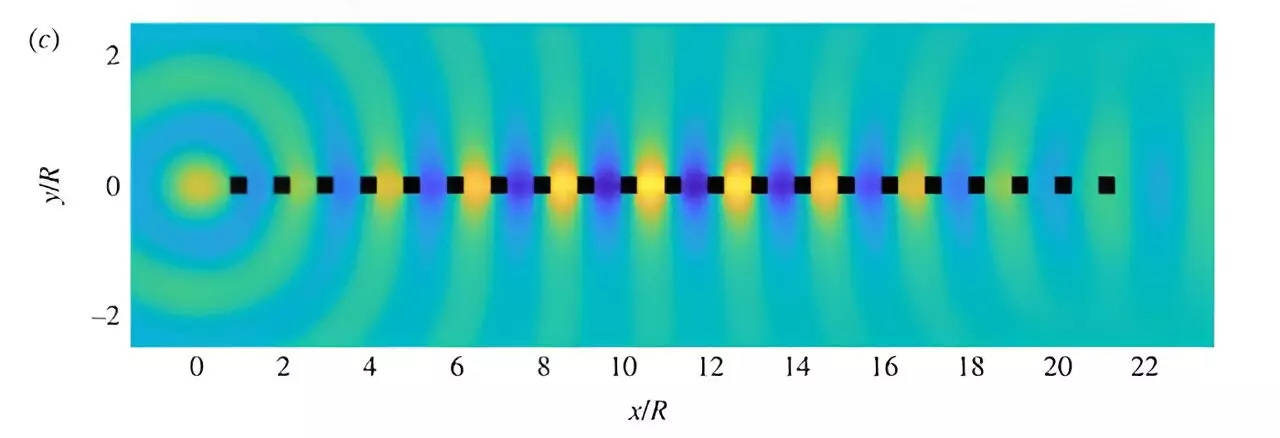Recent advancements in the realm of wave-scattering modeling have emerged from the academic corridors of Macquarie University, manifesting in a new software tool called TMATSOLVER. This innovative package serves as a significant leap forward for researchers and engineers working with metamaterials – fabricated materials with unique properties that manipulate waves, whether they be sound, light, or water. Published in the esteemed journal Proceedings of the Royal Society A on June 19, 2024, this tool possesses the capability to simulate the interactions between complexly shaped particles and various types of waves, a feat that has eluded researchers for decades.
At its core, TMATSOLVER employs the transition matrix (T-matrix), a mathematical construct that represents how specific objects interact with and scatter waves. Traditionally, the T-matrix has presented challenges relating to particles larger than the wavelengths involved, particularly when those particles assume intricate geometries. Dr. Stuart Hawkins, the lead author of the study, asserts that this software marks a substantial improvement in computing T-matrices compared to past methodologies. As such, researchers can now explore computational scenarios that were once deemed impractical, pushing the boundaries of metamaterial research.
The development of TMATSOLVER was not a solitary endeavor; it involved collaboration among mathematicians from eminent institutions, including the University of Adelaide, Imperial College London, and the University of Augsburg. Dr. Luke Bennetts, a co-author and researcher from the University of Adelaide, highlighted the advantages of integrating TMATSOLVER into metamaterial research. It alleviated the computational constraints that often bogged down theoretical exploration, enabling researchers to navigate complex geometrical configurations with unprecedented ease.
The practical applications of TMATSOLVER are vast and varied. The researchers illustrated its potential through four illustrative examples pertaining to metamaterial design, which included the modeling of anisotropic particle arrays and high-contrast periodic structures capable of manipulating wave phenomena. Such developments open doors to groundbreaking applications like super-lenses that provide molecular-scale imaging and invisibility cloaks that achieve complete light refraction. Furthermore, the potential for perfect wave absorption could lead to innovations in energy harvesting and advanced noise reduction solutions.
The significance of TMATSOLVER extends well beyond its functionality; it embodies a transformation in the way researchers can conceptualize and test metamaterials. As stated by Dr. Hawkins, the software is versatile enough to compute T-matrices for a broad spectrum of particle types, catering to the specific properties of each configuration. This flexibility promotes rapid prototyping, allowing for swift testing and validation of theoretical metamaterial designs, thereby accelerating the pace of research in this dynamic field.
Professor Lucy Marshall, the Executive Dean of the Faculty of Science and Engineering at Macquarie University, encapsulates the broader implications of this work by asserting that TMATSOLVER represents a substantial progression in the design and simulation capabilities within materials science and engineering. By harnessing novel computational methodologies, the research catalyzes advancements that could yield transformative breakthroughs in multiple domains reliant on metamaterial technologies.
The introduction of TMATSOLVER is not merely a technical enhancement; it signifies a paradigm shift in metamaterial research. By overcoming previous limitations tied to wave-particle interaction modeling, this software substantially enhances researchers’ capacities to navigate intricate configurations. With continuing exploration catalyzed by TMATSOLVER, the future of metamaterials appears promising, potentially unlocking new applications that may redefine technological capabilities in various fields, from communications to medical imaging. As the study unfolds in the academic and industrial landscapes, the implications of TMATSOLVER will undoubtedly reverberate, fostering a new era of innovative metamaterial design.

